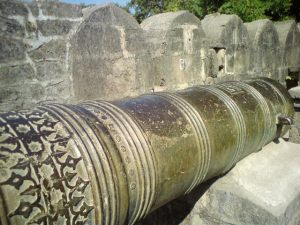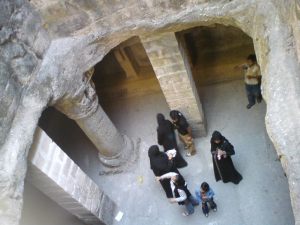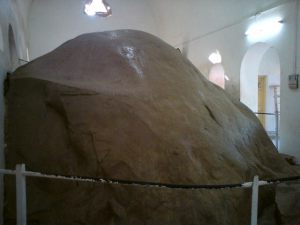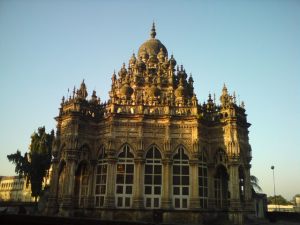Junagadh is one of those towns that has a little of everything. Architecturally it is satisfying and any inquisitive tourist will not be disappointed. It has a fort. Within the grounds of this fort are two ancient stepwells, a Jumma Masjid in ruins and Buddhist caves. There is a beautiful mausoleum from the 19th century. A couple of miles out of town is the pilgrimage spot of Mt. Girnar which is popular with Hindus, Jains and Muslims. Then there is Ashoka’s rock edict which puts Junagadh on the map of ancient India.
First things first. I check out a hotel opposite the bus station. At Rs. 250 is it disappointingly cramped, unclean and without television. Fortunately I have a list of Toran group of hotels run by Gujarat Tourism and they have a hotel in Junagadh. I call them up. The woman on the phone tells me that a room is available. In my experience, their hotels are clean and spacious. Their restaurants make convenient places for meals.
The hotel is near Majewadi Darwaza. This is one of the gates granting access to the inner town surrounded in those days completely by a fort wall. When I arrive after a fifteen minute walk, the room is not ready. While I wait for it to be cleaned, the receptionist starts chatting.
‘I have been on the road for six weeks now,’ I tell in response to her question. Her eyes light up half surprised and half in disbelief.
‘Where have you been?’ she asks with the same interest.
‘Andhra, Orissa, Madhya Pradesh and now I am in Gujarat. I will be moving on to Maharashtra and Goa before returning to Bangalore.’
‘Will you be going to Sasan Gir? It’s nearby.’
‘No.’
She is disappointed by my abrupt response. I do not elaborate on my own disappointment in sighting tigers at Bandhavgarh, with its expensive safaris that went in vain.
‘But I enjoyed Champaner,’ I tell her to make her feel better.
‘Oh! Did you stay at our hotel at Pavagadh?’
‘Yes. It’s a nice one with good views of the mountains around. Their Gujarati thali for dinner is superb.’
‘My husband works there. I am actually from Kerala but I have been in Gujarat for many years now.’
Meanwhile my room is ready and I check in. After unpacking quickly I head out to the fort at Junagadh. It is a long walk past busy streets. It is like any other fort with walls, crenellations, entrance gateways and defensive bastions. I come across three cannons named Neelam, Manek and Kadanal. Apparently, in the 16th century Sultan Bahadurshah, the Sultan of Gujarat invited the Turkish navy to help him against the Portuguese at Diu. The Sultan was killed before help arrive. The Turkish were defeated. The guns were later brought from Diu and installed here at Junagadh. One of the guns is decorated with Arabic script.
Closeby is the Jumma Masjid, a ruin from the 15th century. The mosque is in the Champaner style. Like the Shahr-ki Masjid of Champaner which has five domes, this mosque has three domes. Sadly all three domes collapsed long ago. Interestingly these domes appear to have risen from an elevation at the first storey. Below the domes are the remnant bases of four pillars. How would these pillars have risen to the dome? Would they have supported any structure at all? They may be the only clues to an original building. Perhaps, this was a temple or a palace before it was converted to a mosque.
While the pillars in the prayer hall at the western side of the mosque are joined without arches, the domes are surrounded by arches. Arched aisles separate only dome from the next one. These arches are continued along the length of the prayer hall where the latter joins the domes. This mix of arches and temple style pillared spaces makes this an interesting mosque with unique perspectives.
There are three mihrabs in the mosque. All three are wonderful pieces of art. The central one in particular is a masterpiece. It is framed like a doorway leading to a recessed space. The mihrab wall has a relief of a opened lotus from which hangs a kalasha suspended by a chain. This is a recurring motif so commonly seen in the mosques of Gujarat and best represented in the ruins of Champaner. Mihrabs are interspersed with stone jalis which are quite plain in comparison to the mosques of Champaner or the palaces of Bundelkand.
As I am leaving the mosque I am stopped by a man at the entrance.
‘Come, come. Have darshan for only two rupees,’ he says. He is standing next to a telescope balanced on a tripod. The telescope is pointing to Mt. Girnar in the distance. He tries to convince me by naming the temples on the high slopes which I am guaranteed to see. Guaranteed because this is not bird-watching or open jeep safari. Temples don’t move and neither will the mountain.
Seeing my lack of response, he moves on to another tourist who seems a more potential customer.
‘Can I see the god in the sanctum?’ asks this stupid potential customer.
‘No. Only the temple on the outside,’ replies the telescope guy with disappointment in his voice. He is thinking if there can be such a telescope that he is not aware of.
I walk out just as a group of school kids rush up the stairs to the mosque. Not far from here are the Buddhist caves. None of the sights within the fort with the exception of these caves have an entry ticket. This is clever stuff because the caves are easy to fence off and every visitor to Junagadh is bound to stop at the caves.
Gujarat is not well known for Buddhist Caves when compared to neighbouring Maharashtra. The caves at Junagadh are quite ordinary. Unlike those of Maharashtra, these caves are not on hilly ground. They have been excavated from ground level downwards. The caves are on two levels. At ground level there is evidence of a water and drainage system. At the lowest level, there are some pillars with decorated pedestals and capitals. Much of it has eroded. There is a central open space surrounded by small cells and stone ledges against walls. The caves are nothing compared to Bagh caves.
A little walk brings me to two ancient stepwells located within the fort – Navghan Kuvo and Adi-Kadi Vav. These are two deep wells carved out of virgin rock. They are nothing like the wells I have seen elsewhere. They are primitive, devoid of decoration or advanced architectural elements. There are truly rock-cut architecture, the wells being excavated by the brute of chisel and hammer. The interior walls bear either chisel marks or natural striated lines of eroded rock. Truly these two may well be the oldest of stepwells in India.
I leave the fort and head downtown for lunch. It is past 2.30 pm and I am hungry. After a long walk I finally find a decent place to eat. The food is excellent. Three different types of rotis are served – chappati, butter roti, methi roti. After lunch I go in search of a rock from the past.
‘Is this the way to Ashoka’s rock edict?’ I ask an old man.
‘Yes. Would you be interested in the secret of health?’ he says. Without waiting for an answer he pulls out a book from his satchel. ‘This is my guru,’ referring to a photograph on the cover.
The man has a pleasant countenance and a warm smile. He claims to have written the book.
‘I’ll give it to you for ten rupees from its original price of thirty,’ he says.
I flip the pages and though I don’t find it that interesting, I buy it. It’s written primarily in Gujarati. Three page abridged versions appear in Hindi and English. So I pay ten rupees for three pages. The guy thanks me repeatedly and shakes my hand in joy. Going by this, it would be fair to say he has not sold a book for months. Finally he describes to me in detail the road to Ashoka’s rock.
I arrive at a signboard. I can see no rock but only a building with an entry fee. The rock is sheltered on all sides. It is separated from the surrounding open landscape. This natural piece of earth has been domesticated by man. On it are various letters of an ancient alphabet many of which appear to me as cryptic symbols. Fourteen edicts have been etched on this rock in 3rd century BC at Ashoka’s direction. Each edict is cleanly separated from the others. Translations of these edicts are displayed on the walls. Many of them relate to morality and non-violence. I read all of the translations with interest.
The rock also contains inscriptions from later periods right to the Guptas. They document the floods in the region leading to the break in the bunds of Sudharshan lake.
Having visited all these sights yesterday, this morning I check out of the hotel and go in search of a mausoleum. It is a short walk from my hotel. Soon I am looking at Mahabat Maqbara from across the road. The overhanging canopy of a tree frames the view from above. A passing cyclist is frozen temporarily in my view while the mausoleum towers in the background.
The mausoleum was built towards the end of the 19th century, started by Nawab Mahabat Khan II and completed later by his successor. Many Nawabs are entombed within the main structure. A smaller structure stands nearby within the same courtyard. The buildings are a mix of Indian and European styles. Tall columns standing to support Perpendicular arches give loftiness to the structure. Neo-Gothic elements appear on these columns, the arches and the spandrels. From ground level, the mausoleum can be viewed as a square, a rhombus, a chamfered square or even an octogon. It is in fact octogonal but because porches stand out from four sides in such a proportion, it can be viewed in a number of other ways.
The roof is not a simple dome. It rises in at least three levels of miniature domes, turrets and kiosks. The parapet above is arcaded with pointed arches. The central dome rises above this crowded assemblage of sharp points and bulbous curves. Overall, it is the complexity of the roof that makes this an interesting monument. Whether it is beautiful would clearly depend on the viewer but it is architecturally a masterpiece. Sadly it is not looked after. Many perforated stone windows are broken. Debris is on the inside and outside.
The other building here, which is in parts in a worse state of preservation, has a simpler roof – a single dome surrounded by four smaller corner domes. The central dome has at its base projections of bangla roofs all around it. Four towers surround the building. On each tower a stairway spirals upwards on the outside of the central shaft. By placing the stairways outside with voluted leafy brackets, the towers are made visually more appealing.
While I am making such observations of the place, a young man walks up to me. I am now at an age when anyone younger than me appears young.
‘Don’t leave your bag lying around,’ he points to my backpack in a corner of the courtyard.
‘I am keeping an eye on it,’ I assure him.
He introduces himself as Uday Ghedia. He runs a private tuition center. He is on his way to work but has stopped by to greet me.
‘My hobby is to meet tourists,’ he says. It’s an unusual hobby not many can boast of.
‘I keep meeting lots of people. Some two weeks ago I met a French guy. I showed him around Junagadh. He liked it so much that he has stayed on for days. We celebrated his birthday and also mine just a few days ago.’
He continues to describe his experiences with many other tourists. He then tells me something about this building.
‘Just a few months ago a handful of windows were broken. Today most of the windows are broken. Children come and play here. They are destroying this monument. No one is taking care of it. I tried to get tourists to sign a petition but not many were interested. Most of them say, “not my problem” or “I cannot sign because I am not Indian”.
‘I am trying to push the issue towards ambitious politicians but so far I have not had much success,’ he says ruefully.
‘Don’t misunderstand me. I am not a guide. I can show you around Junagadh if you like,’ he says with a friendly smile.
‘No thanks. I will be leaving within an hour. I plan to head to Diu,’ I tell him. I get his business card. He doesn’t have an e-mail address and he confesses that he is not good with computers. As I walk to the bus station, I realize that I have enjoyed my stay at Junagadh.








As ever enjoyed going through your post. I was sort of glued to it.
Very interesting Arvind.
By: Manish Khamesra on March 14, 2011
at 9:08 am